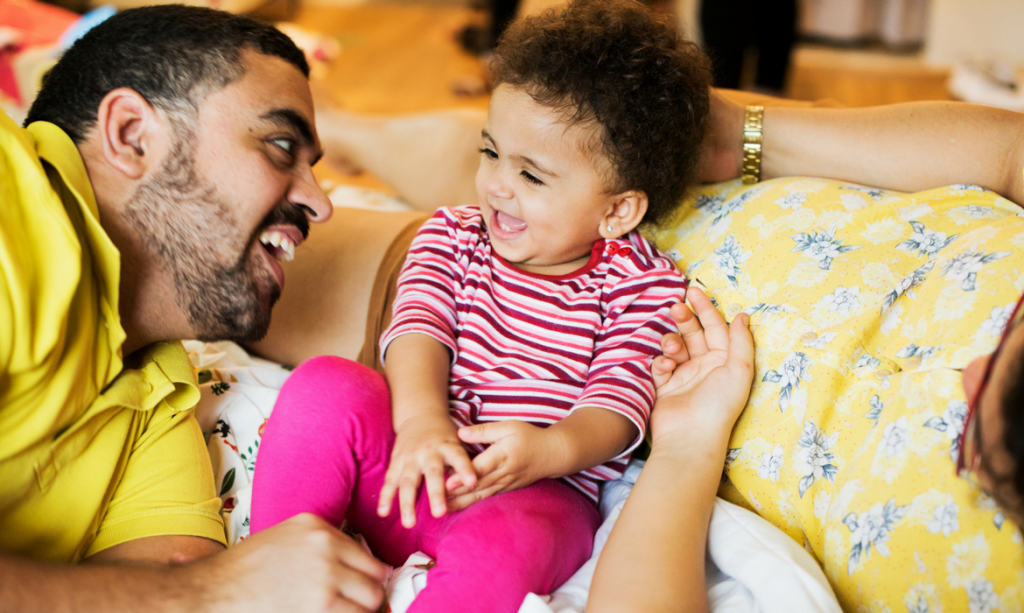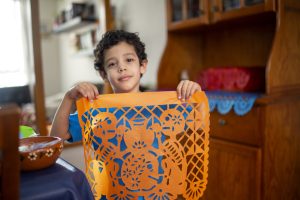Parent talk is critical for infant, toddler, and preschooler learning. It helps build children’s language and social skills as well as their more general understandings of the world. But only recently have we discovered that having conversations about numbers are a type of parent talk that is critical for children’s math learning.
While many parents make an effort to read with preschoolers regularly to support their early language development, they may be less likely to support their children’s early math development and less sure about how to do this. Here we discuss why number talk is important and how parents can make the most of their number talk, helping support children’s math learning at home and in school.
The Importance of Numbers in the Home
Early home learning experiences appear to be an important factor affecting children’s number knowledge when they enter school. [1, 2, 3, 4, 5] Observations of families in their homes, for example, have shown that parents’ number talk during daily routines and play predicts children’s later math knowledge. And, in turn, we have increasing evidence that this early knowledge contributes in lasting ways to later math (and reading!) achievement. [6, 7] However, parents vary greatly in how frequently they talk about numbers with their preschool children. [3, 4, 5]
Why Does Number Talk Matter?
Parents’ number talk helps children learn that number words (e.g., “three”) and numerals (e.g., “3”) represent exact numbers of objects (e.g., three blocks). [8, 9] While we know that children are born well-prepared to learn about numbers, they need help learning to connect number words and numerals to the exact set size each number refers to. And, these understandings of number symbols become increasingly important when children start working with larger numbers in more complex ways, such as solving the arithmetic problems they encounter in elementary school.
How to Support Number Learning
“My three-year-old is great at math—she can count all the way to 20!” It is not uncommon for parents, grandparents, and other family members to be proud of how high their young children can count. Yet, while learning the sequence of counting words is important (in the same way it is important for children to memorize their ABCs), if parents only practice rote counting, it can be difficult for children to learn what the number words mean or how to use their number knowledge. Here are some pointers to help your child learn the meaning of number words:
- Count and discuss the quantity of visible sets of objects, rather than just reciting the counting sequence. Parents’ number talk is most effective at supporting children’s number knowledge when it involves discussion of the quantity of visible objects and comparison of set sizes (e.g., “I have three blocks and you have four.”). [3]
- Count and label the number of objects in a set. This will help children connect the counting procedure to the size of sets. “There are three cars. One, two, three!” [10]
- Use numbers words that are just larger than the numbers your child already understands. Children benefit from number talk that encourages engagement with quantities just beyond their current number understanding. So if your child seems to understand 1, 2, and 3, start talking about 4, 5, and 6. [11]
- Pay attention to your child’s number gestures. Often children respond accurately with gestures when you ask how many but incorrectly with words (e.g., for a set of three cars the child holds up three fingers but says “four cars”). These “mismatches” indicate that your child is ready to learn the word “three”. [12, 13]
- Your gestures can also help! Point to each object in a set while you or your child counts them. Model holding up your fingers to show quantities that you are discussing. Using gestures such as these helps to support children’s mapping of number words to the quantities they represent. [14, 15, 16]
- Take advantage of numbers in your everyday lives. Practice counting while reading picture books. Ask your child to pick out a certain quantity of items during routines such as cleaning up toys or setting the table. Compare quantities of items while building blocks, lining up toy cars, or playing restaurant.
- Talk to your child about how you are using numbers in your daily life. For example, discuss how you use numbers to figure out what to buy, to plan quantities for a meal, or to set the table. This demonstrates the importance of numbers and can help your child see how math is useful.
By making number talk a regular part of daily life, you can help your child build a foundation for their future math learning!
[1] Niklas, F., & Schneider, W. (2014). Casting the die before the die is cast: The importance of the home numeracy environment for preschool children. European Journal of Psychology of Education, 29, 40-50.
[2] Skwarchuk, S. -L., Sowinski, C., & LeFevre, J. -A. (2014). Formal and informal home learning activities in relation to children’s early numeracy and literacy skills: The development of a home numeracy model. Journal of Experimental Child Psychology, 121, 63-84.
[3] Gunderson, E. A., & Levine, S. C. (2011). Some types of parent number talk count more than others: Relations between parents’ input and children’s cardinal-number knowledge. Developmental Science, 14, 1021-1032.
[4] Levine, S. C., Suriyakham, L. W., Rowe, M. L., Huttenlocher, J. & Gunderson, E. A. (2010). What counts in the development of young children’s number knowledge? Developmental Psychology, 46, 1309-1319.
[5] Susperreguy, M. I., & Davis-Kean, P. E. (2016). Maternal math talk in the home and math skills in preschool children. Early Education and Development, 27, 841-857.
[6] Bailey, D., Duncan, G. J., Odgers, C. L., & Yu, W. (2017). Persistence and fadeout in the impacts of child and adolescent interventions. Journal of Research on Educational Effectiveness, 10, 7-39.
[7] Duncan, G. J., Dowsett, C. J., Claessens, A., Magnuson, K., Huston, A. C., Klebanov, P., … Japel, C. (2007). School readiness and later achievement. Developmental Psychology, 43, 1428-1446.
[8] Bloom, P. (2000). How children learn the meanings of words. Cambridge, MA: The MIT Press.
[9] Mix, K. S., Sandhofer, C. M. & Baroody, A. J. (2005). Number words and number concepts: The interplay of verbal and nonverbal quantification in early childhood. Advances in Child Development and Behavior, 33, 305-346.
[10] Mix, K. S., Sandhofer, C. M., Moore, J. A., & Russell, C. (2012). Acquisition of cardinal word principle: The role of input. Early Childhood Research Quarterly, 27, 274-283.
[11] Gibson, D., Gunderson, E. A., & Levine, S. C. (2015, March). Number word learning: A parent driven training study. Talk presented at the Society for Research on Child Development Biennial Meeting, Philadelphia, PA.
[12] Gunderson, E. A., Spaepen, E., Gibson, D., Goldin-Meadow, S., & Levine, S. C. (2015) Gesture as a window onto children’s number knowledge. Cognition, 144, 14-28.
[13] Gibson, D. J., Levine, S. C., Berkowitz, T., Goldin-Meadow. (2017) Analogy and Early Number Learning. Talk presented at the 4th Analogy Conference, Paris, France.
[14] Alibali, M. W., & DiRusso, A. A. (1999). The function of gesture in learning to count: More than keeping track. Cognitive Development, 14(1), 37-56.
[15] Goldin-Meadow, S., Levine, S. C., & Jacobs, S. (2014). Gesture’s role in learning arithmetic. In L. D. Edwards, F. Ferrara, & D. Moore-Russo (Eds.), Emerging perspectives on gesture and embodiment in mathematics (pp. 51-72). Charlotte, NC: Information Age Publishing.
[16] Suriyakham, L. W. (2007). Input effects on the development of the cardinality principle: Does gesture count? (UMI No. 3262306). Retrieved from Dissertations and Theses database.



